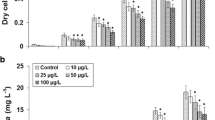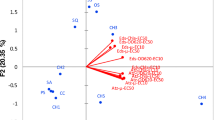Abstract
Biodegradation of γ-hexachlorocyclohexane (lindane) by a nitrogen-fixing cyanobacterium isolated from Chinese paddy soils, Anabaena azotica 118, was investigated. Lindane with an initial concentration of 0.2 mg L−1 in the cultures had no negative effect on the chlorophyll a concentration of A. azotica after 5 d exposure. The tolerance of this cyanobacterium to lindane indicates that it has the potential to biodegrade lindane. The degradation experiments show that the percentage of lindane removal efficiency by A. azotica was 48.8% after 5 d, at an initial lindane concentration of 0.2 mg L−1 and initial A. azotica chlorophyll a concentration of 50 mg L−1. The calculated half-life was 4.78 d. Elevated culture temperature, irradiation, and usage of nitrate as the nitrogen source in the cultures could increase the biodegradation efficiency of lindane. γ-Pentachlorocyclohexene was detected as a metabolite of lindane. The ability of A. azotica to biodegrade lindane has potential use in the bioremediation for this organochlorine pesticide.






Similar content being viewed by others
References
Badea SL, Vogt C, Weber S, Danet AF, Richnow HH (2009) Stable isotope fractionation of γ-hexachlorocyclohexane (Lindane) during reductive dechlorination by two strains of sulfate-reducing bacteria. Environ Sci Technol 43:3155–3161
Benimeli CS, Fuentes MS, Abate CM, Amoroso MJ (2008) Bioremediation of lindane-contaminated soil by Streptomyces sp. M7 and its effects on Zea mays growth. Int Biodeterior Biodegrad 61:233–239
Bueno M, Fillat MF, Strasser RJ, Maldonado-Rodriguez R, Marina N, Smienk H, Gómez-Moreno C, Barja F (2004) Effects of lindane on the photosynthetic apparatus of the cyanobacterium Anabaena: fluorescence induction studies and immunolocalization of ferredoxin-NADP + reductase. Environ Sci Pollut Res Int 11:98–106
Cai QY, Mo CH, Wu QT, Katsoyiannis A, Zeng QY (2008) The status of soil contamination by semivolatile organic chemicals (SVOCs) in China: a review. Sci Total Environ 389:209–224
Castenholz RW (1988) Culturing methods for cyanobacteria. Method Enzymol 167:68–93
El-Bestawy EA, El-Salam AZA, El-Rahman Mansy AEH (2007) Potential use of environmental cyanobacterial species in bioremediation of lindane-contaminated effluents. Int Biodeterior Biodegrad 59:180–192
Jagnow G, Haider K, Ellwardt PC (1977) Anaerobic dechlorination and degradation of hexachlorocyclohexane isomers by anerobic and facultative anaerobic bacteria. Arch Microbiol 115:285–292
Kumar M, Gupta SK, Garg SK, Kumar A (2006) Biodegradation of hexachlorocyclohexane-isomers in contaminated soils. Soil Biol Biochem 38:2318–2327
Kuritz T, Wolk CP (1995) Use of filamentous cyanobacteria for biodegradation of organic pollutants. Appl Environ Microbiol 61:234–238
Kuritz T, Bocanera LV, Rivera NS (1997) Dechlorination of Lindane by the cyanobacterium Anabaena sp. strain PCC7120 depends on the function of the nir operon. J Bacteriol 179:3368–3370
Li YF, Cai DJ, Singh A (1998) Technical hexachlorocyclohexane use trends in China and their impact on the environment. Arch Environ Contam Toxicol 35:688–697
Liba CM, Ferrara FIS, Manfio GP, Fantinatti-Garboggini F, Albuquerque RC, Pavan C, Ramos PL, Moreira CA, Barbosa HR (2006) Nitrogen-fixing chemo-organotrophic bacteria isolated from cyanobacteria-deprived lichens and their ability to solubilize phosphate and to release amino acids and phytohormones. J Appl Microbiol 101:1076–1086
Mohn WW, Tiedje JM (1992) Microbial reductive dehalogenation. Microbiol Mol Biol Res 56:482–507
Nagata Y, Kamakura M, Endo R, Miyazaki R, Ohtsubo Y, Tsuda M (2006) Distribution of γ-hexachlorocyclohexane-degrading genes on three replicons in Sphingobium japonicum UT26. FEMS Microbiol Lett 256:112–118
Nagpal V, Srinivasan MC, Paknikar KM (2008) Biodegradation of γ- hexachlorocyclohexane (Lindane) by a non-white rot fungus Conidiobolus 03-1-56 isolated from litter. Indian J Microbiol 48:134–141
Ohisa N, Yamaguchi M, Kurihara N (1980) Lindane degradation by cell-free extracts of Clostridium rectum. Arch Microbiol 125:221–225
Phillips TM, Seech AG, Lee H, Trevors JT (2005) Biodegradation of hexachlorocyclohexane (HCH) by microorganisms. Biodegradation 16:363–392
Qiu LM, Zhang JY, Luo YM (2005) Residues of HCH and DDT in agricultural soils of North of Zhejiang and its risk evaluation. J Agro Environ Sci 24(6):1161–1165, in Chinese
Quintero JC, Moreira MT, Feijoo G, Lema JM (2005) Anaerobic degradation of hexachlorocyclohexane isomers in liquid and soil slurry systems. Chemosphere 61:528–536
Simon D, Helliwell S (1998) Extraction and quantification of chlorophyll a from freshwater green algae. Water Res 32:2220–2223
Singh A, Lal R (2009) Sphingobium ummariense sp. nov., a hexachlorocyclohexane (HCH)-degrading bacterium, isolated from HCH-contaminated soil. Int J Syst Evol Microbiol 59:162–166
Singh S, Kate BN, Banerjee UC (2005) Bioactive compounds from cyanobacteria and microalgae: an overview. Crit Rev Biotechnol 25:73–95
Suresh BG, Hans RK, Singh J, Viswanathan PN, Joshi PC (2001) Effect of lindane on the growth and metabolic activities of cyanobacteria. Ecotoxicol Environ Saf 48:219–221
Tiedje JM, Quensen III JF, Chee-Sanford J, Schimel JP, Boyd SA (1992) Microbial reductive dechlorination of PCBs. Session 15. In: Pacific Basin Conference on Hazardous Waste, 1992. Proceedings, Bangkok, Thailand. East-West Center. Honolulu, Hawaii
Yao FX, Yu GF, Bian YR, Yang XL, Wang F, Jiang X (2007) Bioavailability to grains of rice of aged and fresh DDD and DDE in soils. Chemosphere 68:78–84
Zhang HB, Luo YM, Teng Y, Zhao QG, Wang HF (2006) DDT residues in the typical soil types of Pearl River Delta region and its potential risk. Soils 38:547–551 (in Chinese)
Zhang H, Yang C, Zhao Q, Qiao C (2009) Development of an autofluorescent organophosphates-degrading Stenotrophomonas sp. with dehalogenase activity for the biodegradation of hexachlorocyclohexane (HCH). Bioresour Technol 100:3199–3204
Acknowledgments
This work was funded by the National Natural Science Foundation of China (No: 20707019), the National Natural Science Foundation of China (No: 21077030) and the Program for Excellent Young Teachers in Hangzhou Normal University.
Author information
Authors and Affiliations
Corresponding author
Rights and permissions
About this article
Cite this article
Zhang, H., Hu, C., Jia, X. et al. Characteristics of γ-hexachlorocyclohexane biodegradation by a nitrogen-fixing cyanobacterium, Anabaena azotica . J Appl Phycol 24, 221–225 (2012). https://doi.org/10.1007/s10811-011-9670-7
Received:
Revised:
Accepted:
Published:
Issue Date:
DOI: https://doi.org/10.1007/s10811-011-9670-7




